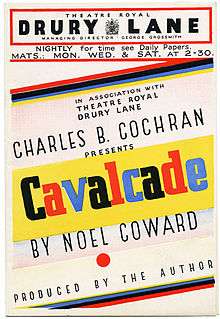Cavalcade (play)
- For the 1933 film adaptation, see Cavalcade (1933 film).
| Cavalcade | |
|---|---|
 Promotional flyer | |
| Written by | Noël Coward |
| Characters |
|
| Date premiered | 13 October 1931 |
| Place premiered |
Theatre Royal, Drury Lane London, England |
| Original language | English |
| Subject | Death, War, Titanic, Great Depression, Romance, 20th century |
| Genre | Drama |
| Setting | Upstairs and downstairs of the Marryot's house |
Cavalcade is a play by Noël Coward with songs by Coward and others. It focuses on three decades in the life of the Marryots, a quintessential British family, and their servants, beginning in 1900 and ends on New Year's Eve in 1929 and is set against major historical events of the period, including the Relief of Mafeking; the death of Queen Victoria; the sinking of the Titanic; and World War I. The popular songs at the time of each event were interwoven into the score.
The play was premièred in London in 1931 at the large Theatre Royal, Drury Lane. The spectacular production involved a huge cast and massive sets. The play was very successful and ran for almost a year. It took advantage of the large stage of the Drury Lane Theatre with its hydraulics and moving components to dramatise the events. The film adaptation in 1933 won an Academy Award for best picture, and the 1970s Television series Upstairs, Downstairs was based on the play.
Background and production
Coward began researching the project while appearing in the Broadway production of Private Lives, finding inspiration in back issues of The Illustrated London News he had brought to New York City with him expressly for that purpose. He also drew on his personal memories for many of the twenty-two scenes in the three-act play.
After returning to London, Coward continued to work on the play. Knowing the size and scope of the project would require as large a venue as possible, he and designer Gladys Calthrop inspected Theatre Royal, Drury Lane and found it to be ideal due to the depth of the stage, the width and height of the proscenium, the various lighting and flying effects that could be achieved, and the six hydraulic lifts that could be utilized to move scenery easily. While Calthrop began the task of designing hundreds of costumes and dozens of sets, Coward worked on the script, which he completed in August 1931. Rehearsals began the following month.
With four hundred cast and crew members involved in the production, Coward divided the crowd into groups of twenty and assigned each a leader. Because remembering individual names would be impossible, everyone was given a color and number for easy identification, thus allowing Coward to direct "#7 red" to cross downstage and shake hands with "#15 yellow and black." Extras were encouraged to create their own bits of stage business, as long as it didn't draw focus from the primary action of the scene.
Cavalcade premiered on 13 October 1931, starring Mary Clare and Edward Sinclair as the Marryot parents and featuring John Mills, Binnie Barnes, Una O'Connor, Moya Nugent, Arthur Macrae, Irene Browne and Maidie Andrews in supporting roles. Despite a brief delay caused by a mechanical problem early in the first act, the performance was a strong success, and the play went on to become one of the year's biggest West End hits, running for 405 performances. The play closed in September 1932.
Opening just prior to the British General Election, the play's strongly patriotic themes were credited by the Conservative Party for helping them secure a large percentage of the middle class votes, despite the fact Coward had conceived the project a full year before the election was held, and the playwright strenuously denied having any motivation to influence its outcome. King George V and Queen Mary attended the performance on election night and received Coward in the Royal Box during the second interval.
The play received its first revival in 1981 at the Redgrave Theatre in Farnham in a production directed by David Horlock and with a cast of 12 professional actors and 300 amateur performers. The production was filmed by the BBC and shown in 1982 as a two-part documentary, Cavalcade - A Backstage Story.[1][2]
Owing to the size and sheer cost of production, Cavalcade has not been staged on the scale of its original production. The few revivals have trimmed a number of the more spectacular scenes, in particular the finale with its multiple lighting and sound effects depicting industrial and social chaos.
Music
Noël Coward's songs
- "Twentieth Century Blues"
- "Lover of my Dreams" (also known as "The Mirabelle Waltz")
Other composers' songs
- "Soldiers of the Queen"
- "Goodbye, Dolly Gray"
- "If You Were the Only Girl (In the World)"
- "Take Me Back to Dear Old Blighty"
- "Keep the Home Fires Burning"
Film adaptation
The 1933 film adaptation of the same name received critical acclaim and won the Academy Award for best picture.
References
- Gammond, Peter. Oxford Companion to Popular Music ISBN 0-19-280004-3
- Larkin, Colin (ed). Guinness Who's Who of stage Musicals ISBN 0-85112-756-8
- Morley, Sheridan. A Talent to Amuse: A Biography of Noël Coward, Doubleday & Company, Inc., Garden City, New York, 1969, pp. 200–214, 223